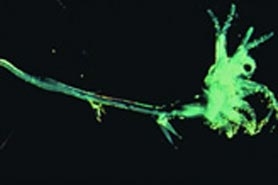Spiny Water Flea
(Bythotrephes cederstroemi)
Spiny water fleas entered the Great Lakes in ship ballast water from Europe, arriving in the 1980s. With translucent bodies, only about ¼ to ½ inches in length, individual water fleas may go unnoticed. However, the species gather in masses on fishing lines and downrigger cables, so anglers may be the first to discover a new population.
Classification in Wisconsin: Prohibited
Ecological Threat
- Spiny and fishhook water fleas are predators - they eat smaller zooplankton (planktonic animals), including Daphnia. This puts them in direct competition with juvenile fish for food.
- Young fish have trouble eating these water fleas due to their long, spiny tails.
- The spiny and fishhook water fleas produce rapidly through parthenogenesis, commonly known as asexual reproduction, which means that no males are required and populations can explode.
Identification
Body: The spiny water flea has a 1/4"-1/2" long, translucent body, making it hard to spot unless gathered in a large cluster. The species is also characterized by a long spine that extends from its abdomen, giving the reason for its name. In addition, the spiny water flea has a dark black eye that can easily be seen against its contrasting light body.
Distribution
See the reported locations of this species in Wisconsin on the Aquatic Species Tracking webpages.
Do you know of additional populations? Send us a report.
Control
Unfortunately, no effective strategy is available to control the spiny water fleas once introduced to lakes.
Resources
Sources for content:



